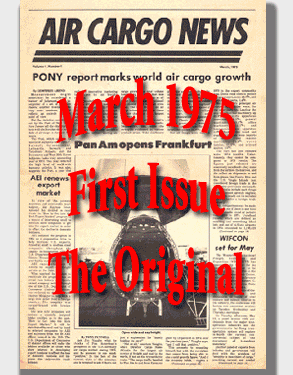
 eeping
up with Richard Malkin, the iconic father of air cargo journalism, “The
Centurion” who glided past 100 years of age just this past June,
is not as easy a task as you might imagine. eeping
up with Richard Malkin, the iconic father of air cargo journalism, “The
Centurion” who glided past 100 years of age just this past June,
is not as easy a task as you might imagine.
As the original air cargo beat reporter, it’s no surprise that Malkin
worked right up to 98 years of age, after which he finally put down his
sword at the publication CNS Focus, rounding out a career in
newspapers and publications that lasted more than 80 years.
Dick started at local New York papers, writing
and editing various dailies and weeklies in his native Bronx, New York,
and later further north in Westchester, New York, but his contribution
to air cargo began in 1943, when he began editing the publication Air
Transportation. It was there that he gave editorial birth to that
publication as it grew and changed into Cargo Airlift and then
Air Cargo World, which he departed in 1978.
Later Richard Malkin would edit Journal
of Commerce’s Air Commerce, followed by a four-year stint at
our Air Cargo News and then a long period of time with IATA
CNS Focus, where he ended his career.
With a surprising air of anticipation not
unlike the feeling experienced before one’s first A380 flight, we
spent a morning recently with Richard, who exited his comfortable home
in New Hyde Park, New York.
We were at once amazed!
At breakfast time there he was, out on the
sidewalk and into the car with great determination, at what is now the
age of 100+.
“My upper body is fine but there are
issues with the legs,” he said, moving faster on the walk then we
could.
But Richard moved in the same way he always
wrote—with purpose and clear focus, willing every part of his being
to answer the call and get him where he wanted to go.
After a century, not much has changed: one
still has to make an effort to keep up with Richard Malkin.
We sat in a place called the Omega Diner
near his home and spoke for a few hours over an omelet and a cup of coffee.
“I started to write a novel, but the
eyes have weakened,” he said.
“We are gong to see what we can do
about that.
“I was asked by Aleks Popovich to
write some text for IATA after I left CNS Focus and got a call
from Air Cargo World very recently to offer some story ideas,
but I just feel at this point that part of my life that went on for such
a long time, is over.
“I do miss writing and keeping up
with air cargo, but must choose what I read and spend my time with these
days.
“There is only so much strength,”
Richard said.
 |

As reported here in June, Richard Malkin
covered the 1948 Berlin Airlift and his stories were picked up all over
the world; with that, air cargo journalism was born alongside a fledgling
industry, as air cargo took off.
We asked him what it was like covering the
Berlin Airlift, and how he came to have his picture taken in his signature
foreign correspondent trench coat and pork pie hat in front of the ruined
Reichstag in 1948.
“I got a call at Air Transportation
from the U.S. Army with an offer to fly to Berlin, so off I went from
Westover AFB in Massachusetts to Berlin.
“I flew the links everyday for a month,
going in and out of Berlin.
“We knew moving tons of coal, milk,
eggs, and clothing, air cargo had really ‘one upped’ the Russians
who blockaded the roadways, so more often than not as we flew the narrow
corridors back and forth to Berlin, they would harass us by sending up
flares to nudge us back into even tighter air lanes in and out of the
city.
“Once on a break we drove over to
the Reichstag and the Army snapped that picture, but our stay was cut
short again as the Russians raised a ruckus.
“It was a tense time, but we knew
that we had won the day almost from the first flight, although the aircraft
landing at Tempelhof would come in at such a steep angle to overcome buildings
around the main runway, most often the aircraft made a pancake landing—meaning
one second you were up on final, and the next down flat on the runway.
“I remember the courage, dedication,
and sense of purpose of all the fliers and ground support people at The
Berlin Airlift was just superb.”

As he returned home and continued his writings,
the “Malkin Style” of air cargo reporting always included
great preparation for all interviews.
Richard would carry index cards with 30
or 40 questions written in advance of any encounter.
Often post-interview, after his stories
had worked their wonders, Malkin subjects would comment that Richard knew
more about what made air cargo work than they did.
To this day, Richard admits he spent the
best years of his life at an airport cargo area, where he made history
one story after another, at a time when he was the only one doing that
kind of work.
“Air cargo was good to me, and brought
me a living wage when working at local newspapers paid half as much.”

“I went in for an interview to get
the job at Air Transportation in competition with two others,
including a reporter from The New York Times and another from
The New York Herald Tribune.
“Just prior to leaving home, my son
Barry, who I guess was about five at the time, pinned a set of wings on
my jacket that he had gotten in a box of Cracker Jacks for good luck.
“Some years later, my first boss,
John Budd, said one of the reasons I was hired had to do with those wings.
“‘We figured you knew something
about aviation,’ Budd said.
“All I knew was that with a growing
family, air cargo would double my $45.00 a week salary.”

“It’s changed,” he said,
when he heard of the cadres of executives who—with little background
in cargo or even, in some cases, aviation—are now heading up air
cargo operations.
“It’s the same,” he replied,
as we spoke of overcapacity in every market with a pulse in 2013.
“Wonder when FedEx is going to get
into the ocean business—that would really close the circle,”
he said.
“They have already conquered air and
road.”
The thing that is so positive about Richard
is that despite the drawbacks of age, he continues to persevere.
“I learned from a very young age that
you always have to work, but you should also enjoy what you are doing,”
he said.
“Right now I am working on getting
the vision back a bit, and then we can move ahead,” Richard Malkin
assures.
That’s 101 from the man who invented
air cargo journalism.
Stay tuned—we will be doing breakfast
again, but next time, I’ll wear my track shoes.
Geoffrey
|










